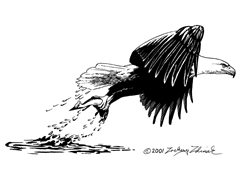Extension Wildlife & Fisheries Specialists Conferences

Triennial National Wildlife and Fisheries Extension Specialists Conference: 11th (2006)
Date of this Version
October 2006
Document Type
Article
Abstract
Most private impoundments have multiple uses for either livestock watering, irrigation, aquaculture, and/or recreation. Infestations of aquatic vegetation can have negative impacts on these multiple uses by 1) hindering feeding and harvesting operations, 2) reducing recreational access, 3) clogging irrigation systems, 4) increasing evaporation rates by as much as 30%, 5) increasing eutrophication rates by 2- to 3-fold, 6) negatively impacting water quality for fish and wildlife species, 7) shifting the balance of the fish population (e.g., stunting), and 8) increasing breeding areas for mosquitoes and other insect pests. Many of the most noxious aquatic plants are non-indigenous invasives. Aquatic vegetation identification and management in private and public waters is a perplexing challenge. Many species of native and non-indigenous aquatic plants invade and establish nuisance communities in private and public impoundments. Fisheries and wildlife biologists, Government personnel, landowners, and purveyors of aquatic herbicides in general have limited backgrounds in aquatic vegetation identification and control options. Yet with 212 major reservoirs and over a million private impoundments in Texas, this is a common clientele demand. Government personnel, landowners, and the public need expert assistance with aquatic vegetation management. Extension specialists with the Department of Wildlife and Fisheries Sciences developed a deck of aquatic plant identification cards, posters, and a web-based knowledge base (AQUAPLANT) to help identify and manage aquatic vegetation problems.


Comments
Published in Proceedings, 11th Triennial National Wildlife & Fisheries Extension Specialists Conference, October 14-18, 2006, Big Sky, MT.